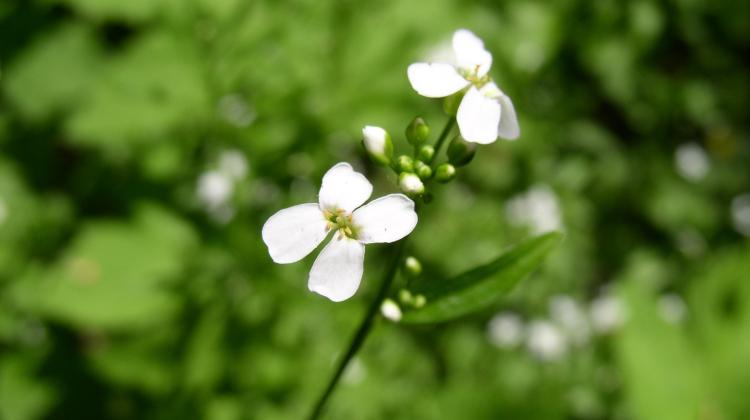Inconspicuous plant with metal right up its alley

It is inconspicuous, delicate, and originates from mountainous areas. Over time, it started to settle on mining dumps and in mines. Rockcress of the Arabidopsis halleri species is one of the few hyperaccumulators - plants that store extraordinary high concentrations of metals. Scientists will use its properties to detoxify soil.
Rockcress of the Arabidopsis halleri species is a perennial originating from mountainous areas. It turned out, however, that it is also no stranger to quite different, far less friendly living conditions, for example mining heaps, post-mining areas with large concentrations of metals in the soil. "Rockcress has natural tolerance and an ability to accumulate metals, thus gaining the status of hyperaccumulator" - told PAP Dr. Alicja Babst-Kostecka from the W. Szafer Institute of Botany of the Polish Academy of Sciences. Rockcress is among only 400 species that have 100 to 500 times higher concentrations of metals in their above-ground parts than average plants.
Scientists do not yet know what causes this inconspicuous plant to choose such difficult places to live and boast of such properties. "Probably, far in the history of this species, a totally unnecessary at the time mutation in the plant\'s genome appeared. This mutation has allowed the plant to be a pioneer and the first to enter the metal-bearing areas" - the researcher explained.
It is also known that difficult living conditions are not a problem for rockcress, because like all hyperaccumulators its physiological processes have adapted. The plant does not have any visible effects of toxic substances, such as discoloration. It is perhaps a little smaller than in the uncontaminated areas, but it blossoms and produces a large number of seeds.
There are many hypotheses to explain why plants hyperaccumulate metals. According to one of them, high concentrations of metals in its leaves protect the plant from being grazed upon by herbivores. According to another, rockcress leaves falling in autumn degrade, and metals return to the soil, which increases their concentration in the substrate. This in turn reduces the likelihood of the appearance of another, competitive species, which could steal sunlight from Arabidopsis halleri.
All halleri Arabidopsis populations tested so far in Europe tolerate and hyperaccumulate metals, regardless of whether they are growing in high metal concentration areas, or in clean areas. "From a physiological point of view, it is a mystery. This phenomenon inspires us to conduct further studies to explain, among other things, why the plant needs such a huge amount of metal" - explained Dr. Babst-Kostecka.
As part of her project, co-financed by the Foundation for Polish Science, researchers investigate the genetic and physiological basis of the phenomenon of hyperaccumulation of metals - especially zinc - by rockcress. "It is an ideal material for research. We can very easily propagate it even with home methods. This allows us to plant it in a variety of habitats and environments, conduct research on the same genotype, but in several different reps" - described the researcher.
At the position in the Tatras - next to the plants that grew there - scientists planted specimens from heaps in Olkusz. "We measured the plants regularly to check whether the native plants would develop better in comparison to the plants transplanted from Olkusz. We will conduct genetic analysis, looking for differences in the genotype of plants from individual positions. We will have a database of environmental data that will allow us to determine whether any genetic change we find is associated with the adaptation of plants to environmental conditions. Genes identified in this way may be responsible for the ability to hyperaccumulate metals. Later, we can look for the same genes in other plants" - explained Dr. Babst-Kostecka.
The hopes associated with the use of rockcress are enormous. It can be used, for example, for phytoremediation, restoration of polluted sites. "This particular plant is not large - a small rosette the size of your hand - so it produces little biomass. It is therefore not efficient and will not detoxify much soil. However, with slightly contaminated soils using it for this purpose would make sense. In China, research into this is already being conducted" - said the researcher.
"I am against genetic transformation, but its supporters might be tempted to transform the genes responsible for hyperaccumulation to other plants that produce high biomass and use them to detoxify soils on a larger scale" - she explained.
Hyperaccumulators can also be introduced on contaminated sites. "Quick effect can be achieved by stabilizing the soil by planting plants of this type, which prevent the penetration of harmful substances into the water and the spread of metal dust by the wind" - she emphasised.
PAP - Science and Scholarship in Poland, Ewelina Krajczyńska
ekr/ mrt/
tr. RL
Przed dodaniem komentarza prosimy o zapoznanie z Regulaminem forum serwisu Nauka w Polsce.
















